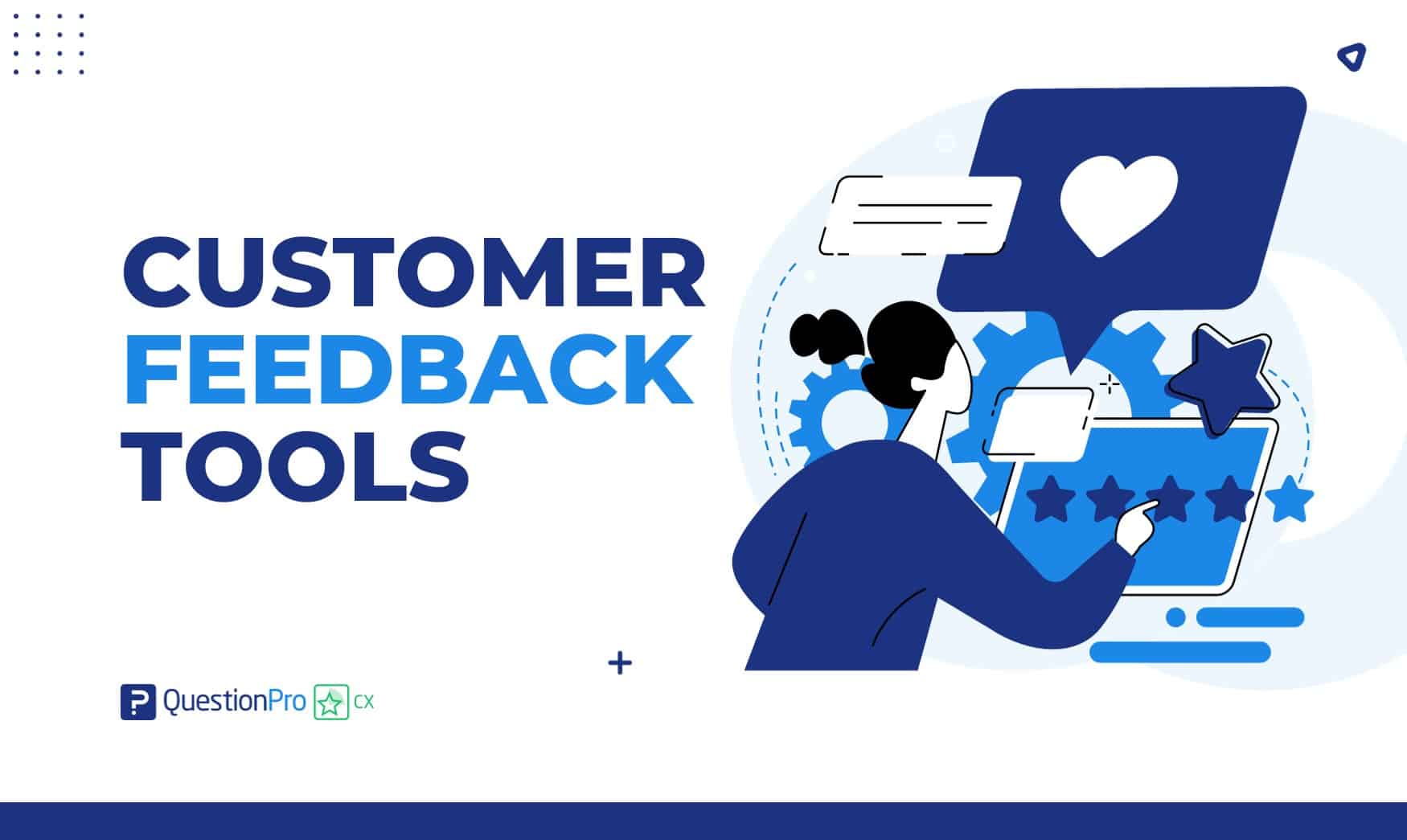
Understanding your customers is the key to customer success. Customer feedback tools play a crucial role in unlocking valuable insights. It helps you improve your products, services, and overall customer experience.
In this blog, we will explore 20 customer feedback platforms and their remarkable features. We will also discuss the pros and cons of each tool. Moreover, this blog also guides you on how to choose the right customer feedback tool for your business. Stay with us to explore!
What is Customer Feedback?
Customer feedback is like the thoughts and opinions customers share about a product, service, or company. It can come in different forms, such as answering questions, leaving reviews, or giving comments. Companies ask for feedback to understand what customers like and dislike and how they can improve.
It’s a way for customers to have a say in making products and services better. So, customer feedback is like a conversation between customers and companies, helping both sides understand each other and make things even more awesome.
What is a Customer Feedback Tool?
A customer feedback tool is software that helps businesses collect, manage, and analyze the opinions and perceptions of anyone using your services or products. These customer feedback tools are designed to make it easier for companies to understand what their customers think about various aspects related to the customer journey and their overall experience.
Customer feedback tools include a variety of technologies and methodologies such as customer feedback surveys, review platforms, comment forms, polls, and more. The goal is to gather valuable insights that companies can use to improve their offerings. It helps to measure customer satisfaction and make informed business decisions.
These customer feedback tools often provide analytics and reports to help businesses track trends and identify areas for improvement based on the feedback received from their customers.
Why Do You Need Customer Feedback Tools for Your Business?
Customer feedback tools have become a crucial pillar for businesses interested in providing an excellent experience to their consumers. Below, we list some of the main ones so that if you’re not already doing so, you can start taking action on them.
Provide Insight into Customer Satisfaction
Customer feedback tools provide insights into how satisfied or dissatisfied customers are with your products or services. This information is crucial for understanding the customer experience and identifying areas for improvement.
Improve Product and Service
Feedback tools help businesses identify specific issues or pain points that customers may be facing. This information allows businesses to learn about how to improve their products or services. It also helps you to enhance customer satisfaction.
Boost Customer Engagement
Actively seeking feedback from customers shows that you value their opinions. This engagement fosters a positive relationship between you and your customers. Responding to feedback also allows for direct communication and can help build trust.
Identifying Trends and Patterns
Analyzing customer feedback over time can reveal trends and patterns. Businesses can use this information to identify recurring issues or positive aspects of their offerings. It also enables them to make strategic decisions based on data.
Competitive Advantage
Understanding what customers like or dislike about your products or services can give you a competitive advantage. By addressing customer concerns and meeting their needs more effectively than competitors, you can differentiate your business in the market.
Offer Innovation
Customer feedback can provide valuable insights for innovation. Customers may offer suggestions for new features or improvements that the business might not have considered. This can inspire innovation and help the business stay ahead in a competitive market.
Measure Customer Loyalty
Feedback tools often include metrics such as Net Promoter Score (NPS), which measures the likelihood of customers recommending a business to others. This metric provides a snapshot of overall customer loyalty and can guide the improvement of customer advocacy.
Make Data-Driven Decision
Using customer feedback as a source of data allows businesses to make informed, data-driven decisions. This approach is more strategic and less reliant on guesswork. It leads to better business outcomes.
Enhanced Employee Morale
Positive customer feedback can boost employee morale by validating their efforts. Constructive criticism can be used as a learning opportunity. It encourages employees to improve and align their efforts with customer expectations.
Top 20 Customer Feedback Tools
In the market, there are plenty of options to cover a wide range of needs, each offering a unique approach to understanding and enhancing your customer’s experience. With so many options, it can be challenging to choose the right one. To help you with that, we have compiled the best customer feedback tools of 2025 along with some of their key features so you can research them further and find the one that best fits your needs.
01. QuestionPro
QuestionPro is one of the top customer feedback tools in the market. It’s commonly known as the leader among survey software, but it also has other divisions and functions that allow its users to delve into consumer perceptions.
One of its most suitable options for this type of need is its suite known as QuestionPro CX, a platform focused on managing customer experience and all points related to providing excellent service.
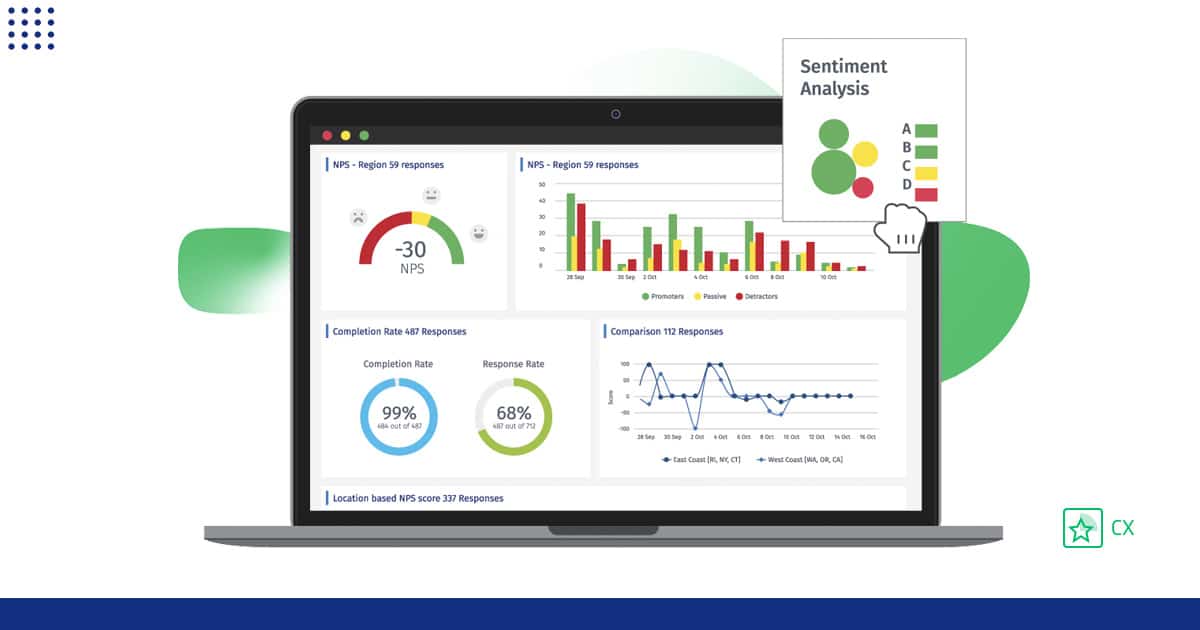
Below, we’ll show you some of the key features that stand out above its competitors.
Best Features:
- SuiteCX: A set of advanced tools for creating a personalized customer journey to identify touchpoints between customers and your business.
- Survey Software: Create surveys in seconds, all with an amazing appearance and a wide collection of question types and logics to collect truly valuable data that allow you to take action and improve every aspect of your business.
- All-in-one CX dashboard: Analyze all your survey data in a way you’ve never experienced before. Use our customizable widgets to tailor the dashboard to your needs, share it across your organization, and collaborate with your colleagues on various ways to interpret the important metrics for your mission.
- Advanced methodologies to better understand your customers: From NPS to Sentiment Analysis, access a wide range of options to collect relevant data.
- Advanced integrations: Take your customer experience program to new heights by integrating QuestionPro CX with the best specialized platforms in the market, from spreadsheets to CRMs.
Pros:
- CX Workflow Powered by AI
- Permits multiple users to access data
- Robust analytics & advanced dashboards
- NPS, Churn risk & Sentiment analysis
- Closed loop
- Dedicated support through various channels: phone, chat, and email.
Cons:
- Limited free version but includes a trial with all advanced features.
Are you interested in learning more about the platform? Our advisors would be delighted to learn about your projects and find solutions for your biggest challenges.
02. AskNicely
AskNicely is your key to happy customers and a thriving business growth. This user-friendly tool focuses on measuring customer loyalty and customer retention. It is also designed for snall business or large businesses. AskNicely makes it easy to collect customer feedback and understand your Net Promoter Score (NPS).
Best Features:
- NPS tracking and analysis.
- Integration with CRMs for streamlined workflows.
- Mobile app for on-the-go feedback.
Pros:
- Specialized in NPS.
- User-friendly interface.
Cons:
- Limited survey types.
03. Typeform
Typeform is your tool for creating interactive and engaging targeted surveys effortlessly. This customer feedback platform is perfect for businesses, small and large. It simplifies the survey process with its conversational design. With Typeform, you can create visually appealing forms that resonate with your audience.
Best Features:
- Conversational form design.
- Conditional logic for dynamic surveys.
- Integration with popular apps.
Pros:
- Modern and visually appealing.
- Versatile question types.
Cons:
- Limited features in the free version.
04. SurveySparrow
SurveySparrow introduces a conversational twist to surveys, making feedback engaging and interactive. It focuses on real-time analytics. SurveySparrow offers businesses a fresh approach to gain valuable insights.
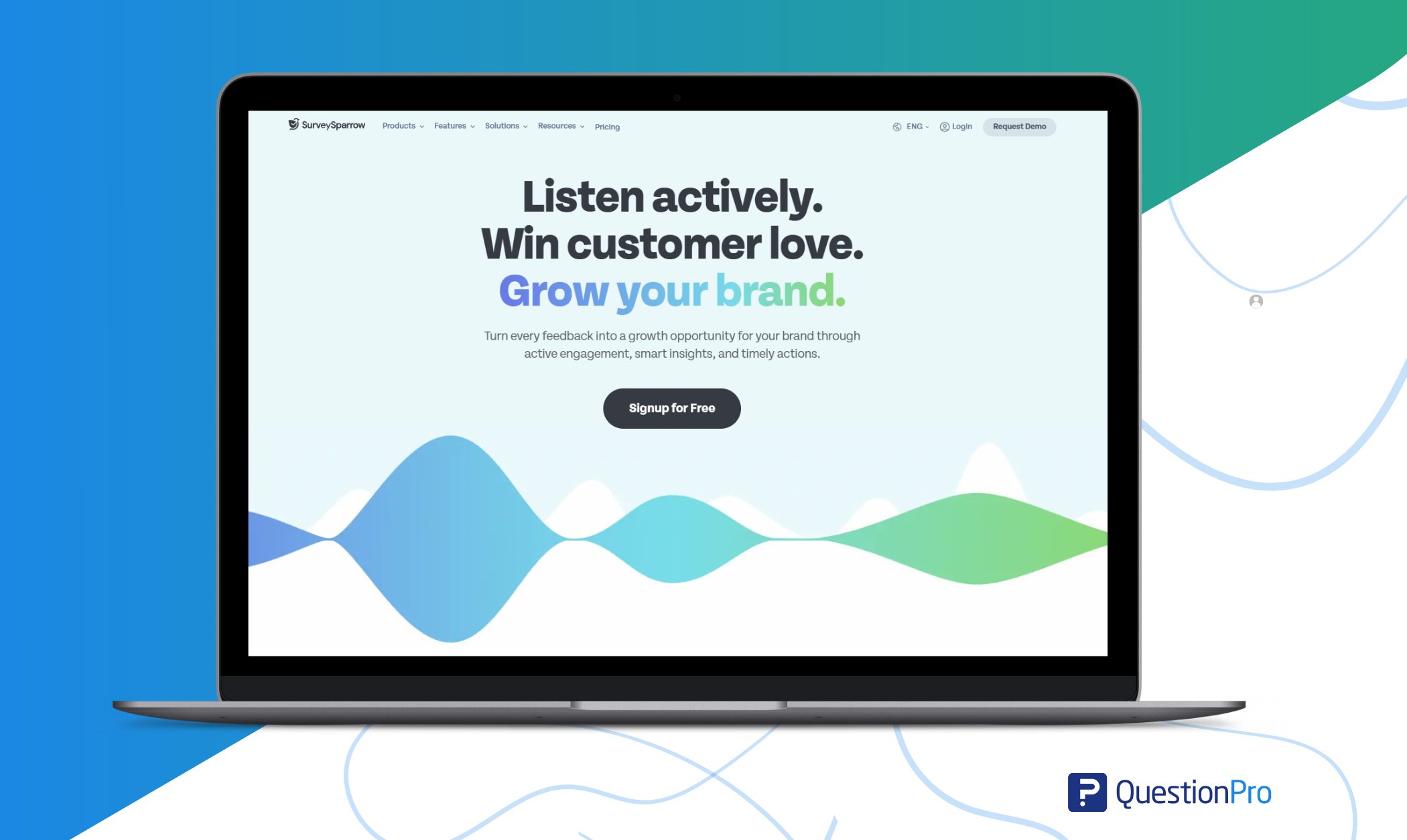
Best Features:
- Chat-like surveys for a personalized touch.
- Customizable survey themes and branding options
- Integration with popular business tools like Slack, Salesforce, and HubSpot
Pros:
- High response rates.
- Intuitive interface.
Cons:
- Limited free plan.
05. Zonka Feedback
Zonka Feedback is your go-to tool for understanding what your customers think. This customer feedback platform is tailored for businesses of all sizes. It’s simple and user-friendly.
This tool goes beyond basic surveys, letting you connect with customers on various platforms, from online to in-person kiosks. Zonka Feedback not only helps collect feedback but also closes the feedback loop in real-time, turning customer insights into actions.
Best Features:
- Omni-channel feedback collection.
- Real-time reporting.
- Customizable surveys.
Pros:
- Diverse feedback collection channels.
- Easy to set up.
Cons:
- Some features are only available in higher-tier plans.
06. SoGoSurvey
SoGoSurvey is a comprehensive survey and feedback platform suitable for businesses of all sizes. This customer feedback platform offers diverse survey types, customizable templates, and advanced reporting and analytics, all in one place. It’s not just about asking questions; it’s about gaining valuable insights effortlessly.
Best Features:
- Diverse survey types.
- Customizable templates.
- Advanced reporting and analytics.
Pros:
- Versatility in survey creation.
- Multiple survey types
Cons:
- Some advanced features may require a learning curve.
07. SurveyMonkey
SurveyMonkey is your easy-to-use tool for gathering insights. Perfect for businesses, big or small, it simplifies the feedback process. With SurveyMonkey, creating surveys is a breeze, and you can analyze results effortlessly.
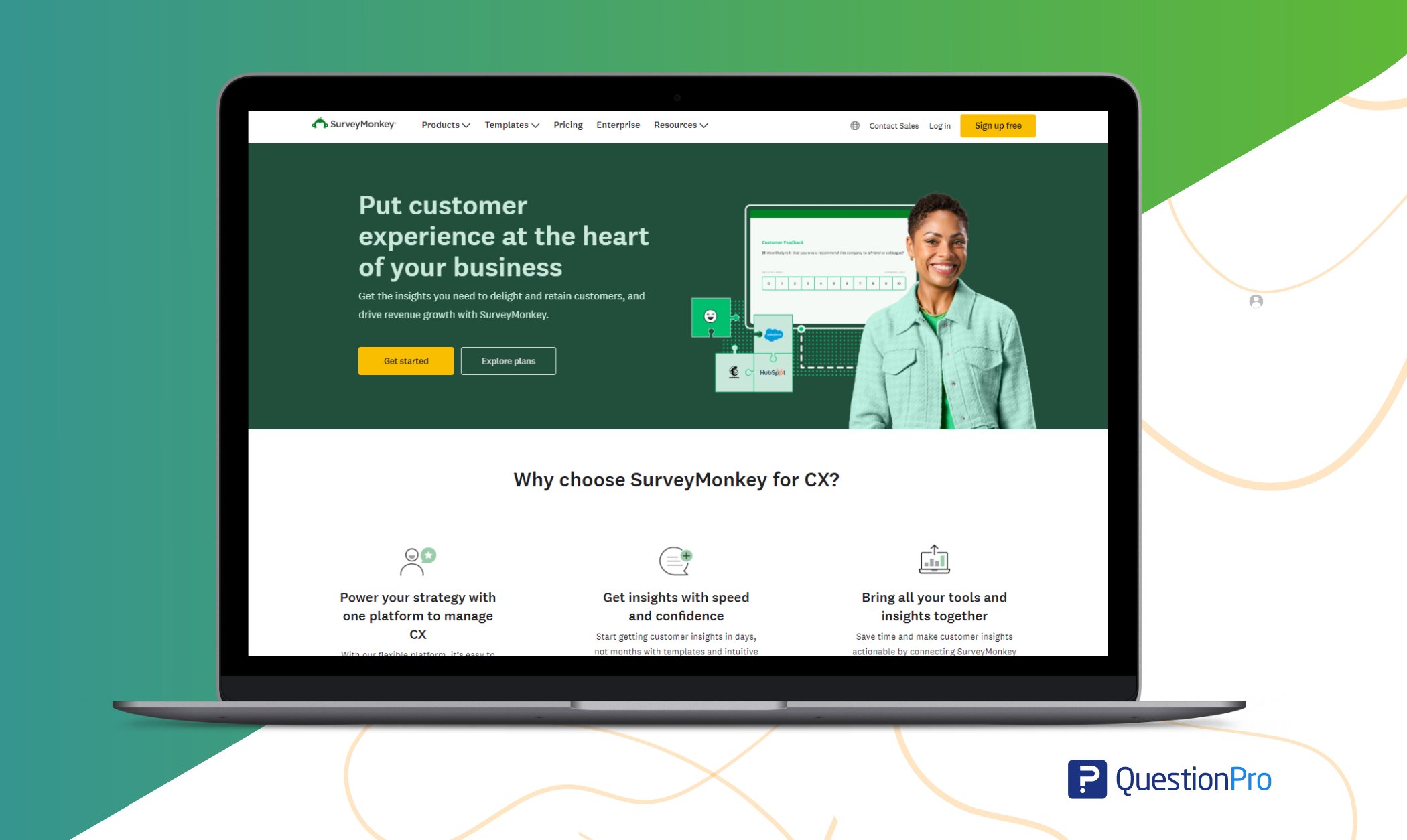
Best Features:
- Extensive question bank for varied surveys.
- Integration with third-party tools.
- Robust data analysis features.
Pros:
- User-friendly for both creators and respondents.
- Powerful analytics.
Cons:
- Some advanced features are available only in paid plans.
08. Qualtrics
Qualtrics is your ticket to understanding your customers and improving their experience. It’s a user-friendly tool for businesses of any size. With Qualtrics, measuring feedback is simple, and you get more than just numbers; you get actionable insights. It helps in creating a seamless experience for your customers.
Best Features:
- Advanced analytics and reporting.
- Automated feedback triggers.
- Integrations with CRM and other systems.
Pros:
- Enterprise-level capabilities.
- Scalable for large organizations.
Cons:
- Higher pricing for advanced features.
09. CustomerSure
CustomerSure makes gathering and managing feedback easier. This customer feedback tool is simple for businesses of any size to use. With CustomerSure, you can automate feedback requests, quickly identify improvement areas, and boost your overall customer experience. It’s not just about collecting feedback; it’s about making informed decisions that lead to happier customers.
Best Features:
- Automated feedback requests.
- Root cause analysis for negative feedback.
- Integration with helpdesk software.
Pros:
- Emphasis on insights.
- Easy feedback management.
Cons:
- Limited customization options.
10. Qualaroo
Qualaroo is an easy way to understand your audience and enhance your business. Whether you’re a small startup or a big player, this user-friendly tool simplifies the feedback process. With Qualaroo, asking the right questions becomes second nature, helping you gather customer feedback.
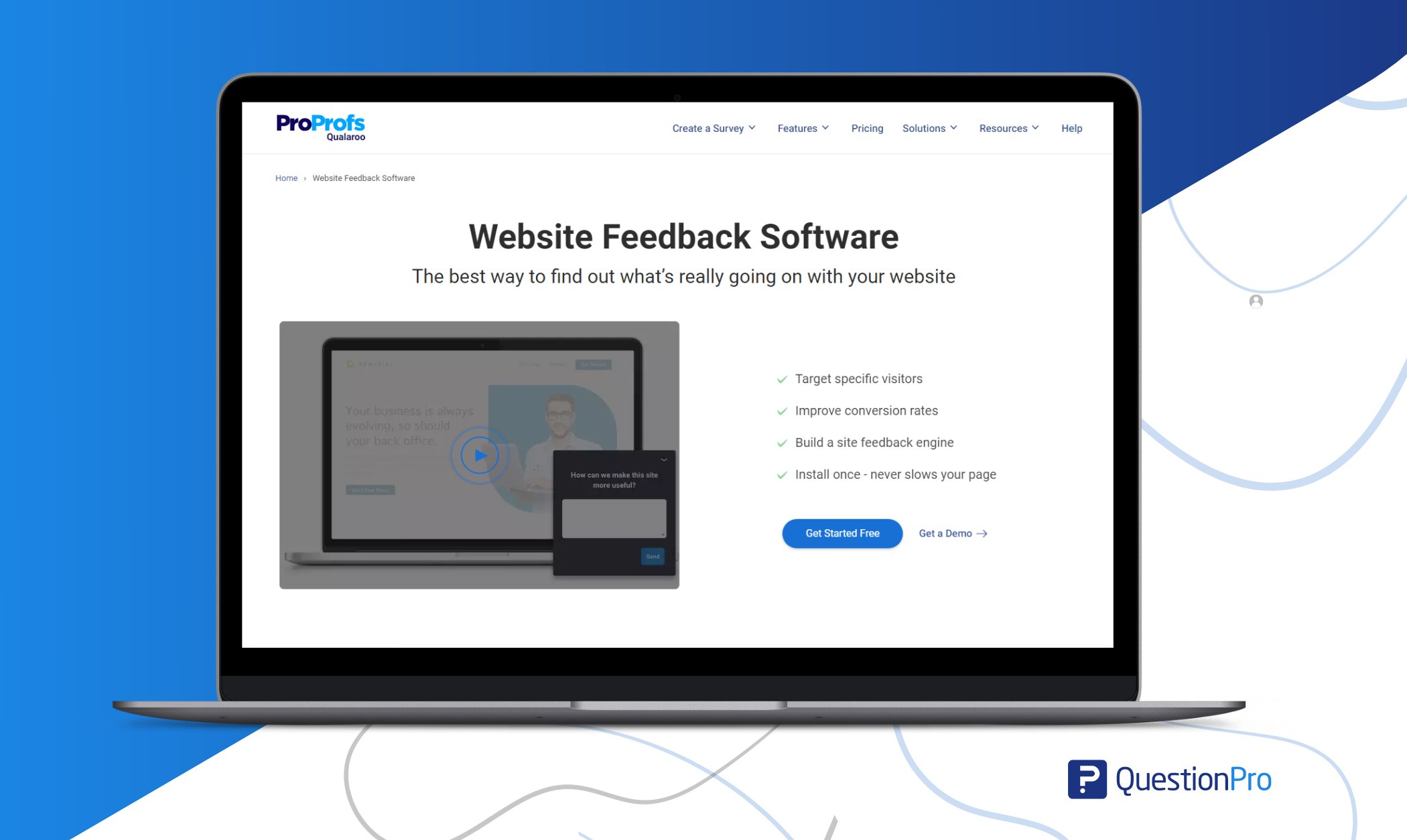
Best Features:
- Behavior-triggered surveys.
- In-depth insights into user intent.
- Easy integration with other customer feedback tools.
Pros:
- A unique approach to feedback collection.
- Strong feedback analysis.
Cons:
- Limited survey customization.
11. Nicereply
Nicereply specializes in measuring customer satisfaction by focusing on feedback from support interactions. This tool is perfect for businesses with a strong emphasis on customer service. Nicereply not only helps measure satisfaction but also provides actionable insights for improving support processes.
Best Features:
- Support ticket integration for measuring satisfaction.
- Real-time feedback analytics.
- Integration with helpdesk software.
Pros:
- Specifically designed for customer support.
- Easy-to-understand analytics.
Cons:
- Limited use outside of customer service scenarios.
12. Feedier
Feedier offers a unique approach to feedback by turning the process into a rewarding experience. This gamified feedback platform encourages users to provide valuable insights by offering incentives. It’s an innovative solution for businesses looking to increase engagement and gather feedback in a fun way.
Best Features:
- Gamified feedback collection.
- Customizable incentives for respondents.
- Advanced analytics and reporting.
Pros:
- Engaging feedback experience.
- Innovative incentive system.
Cons:
- It may not suit traditional feedback collection needs.
13. InMoment
InMoment is your solution for easy and effective customer feedback management. With InMoment, you not only collect feedback but gain actionable insights through advanced analytics and artificial intelligence.
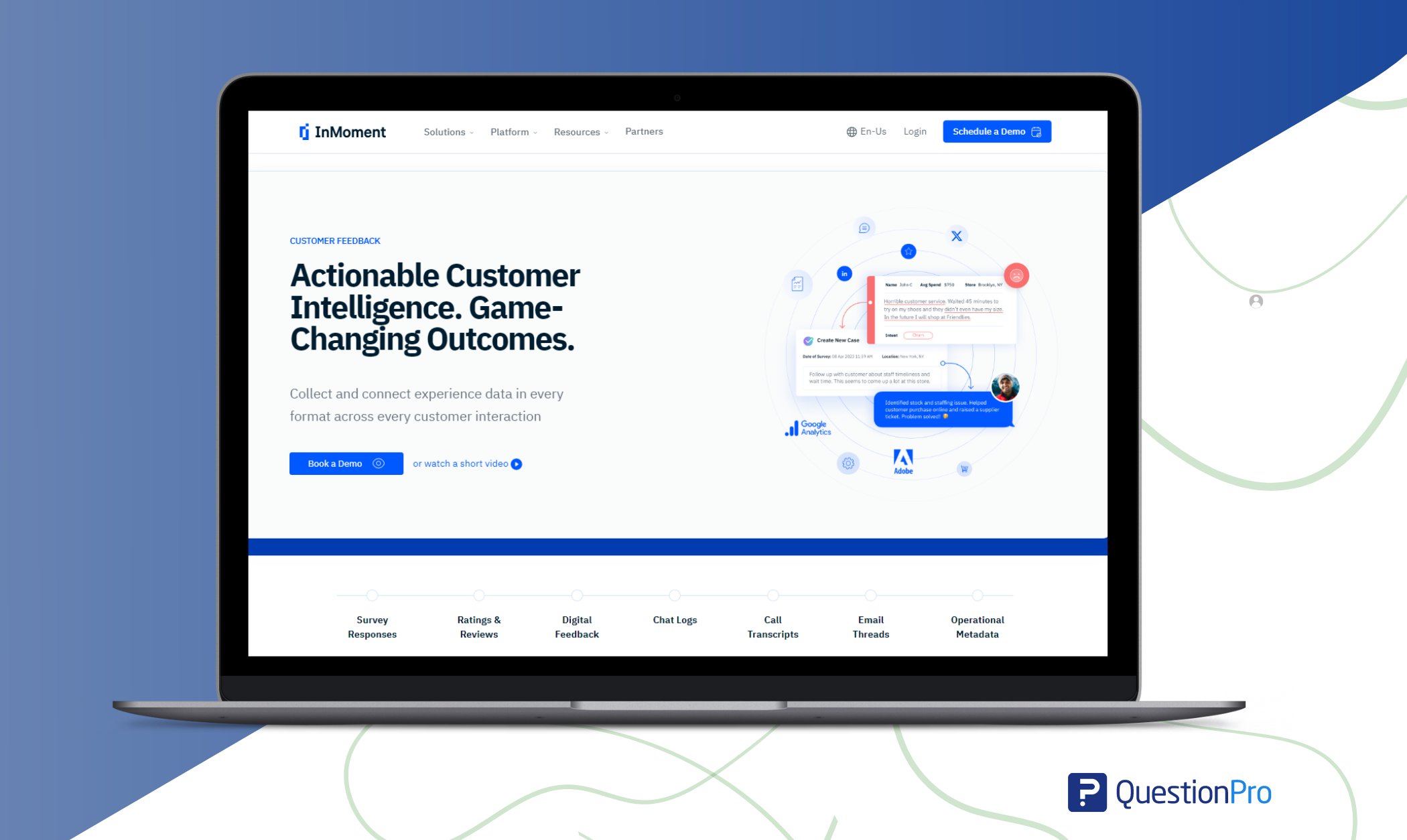
Best Features:
- Advanced analytics and artificial intelligence.
- Journey mapping for comprehensive insights.
- Employee feedback capabilities.
Pros:
- Comprehensive XI platform.
- Robust analytics.
Cons:
- It may be overwhelming for small businesses.
14. GetFeedback
GetFeedback is your straightforward solution for collecting customer feedback. You can effortlessly create mobile-friendly surveys, integrate with Salesforce, and access real-time reporting with GetFeedback. This customer feedback platform helps you understand your customers in a snap.
Best Features:
- Mobile-friendly surveys.
- Integration with Salesforce.
- Real-time reporting.
Pros:
- Salesforce integration.
- Responsive surveys.
Cons:
- Limited customization options.
15. Alchemer
Alchemer, formerly known as SurveyGizmo, is a powerful feedback tool designed to meet the requirements of businesses seeking advanced survey capabilities. With its robust features, Alchemer allows you to create complex surveys and gather detailed insights.
Best Features
- Advanced survey customization options.
- Complex branching and logic for in-depth surveys.
- API integrations for seamless data flow.
Pros:
- Versatile survey creation.
- In-depth analytics.
Cons:
- It may be overwhelming for beginners.
16. Survicate
Survicate is a customer feedback tool designed to help businesses understand their customers better. With a focus on versatility, Survicate allows you to collect feedback through various channels, including websites, emails, and mobile apps. It’s a dynamic comprehensive solution for organizations seeking a multi-channel approach to collecting feedback.
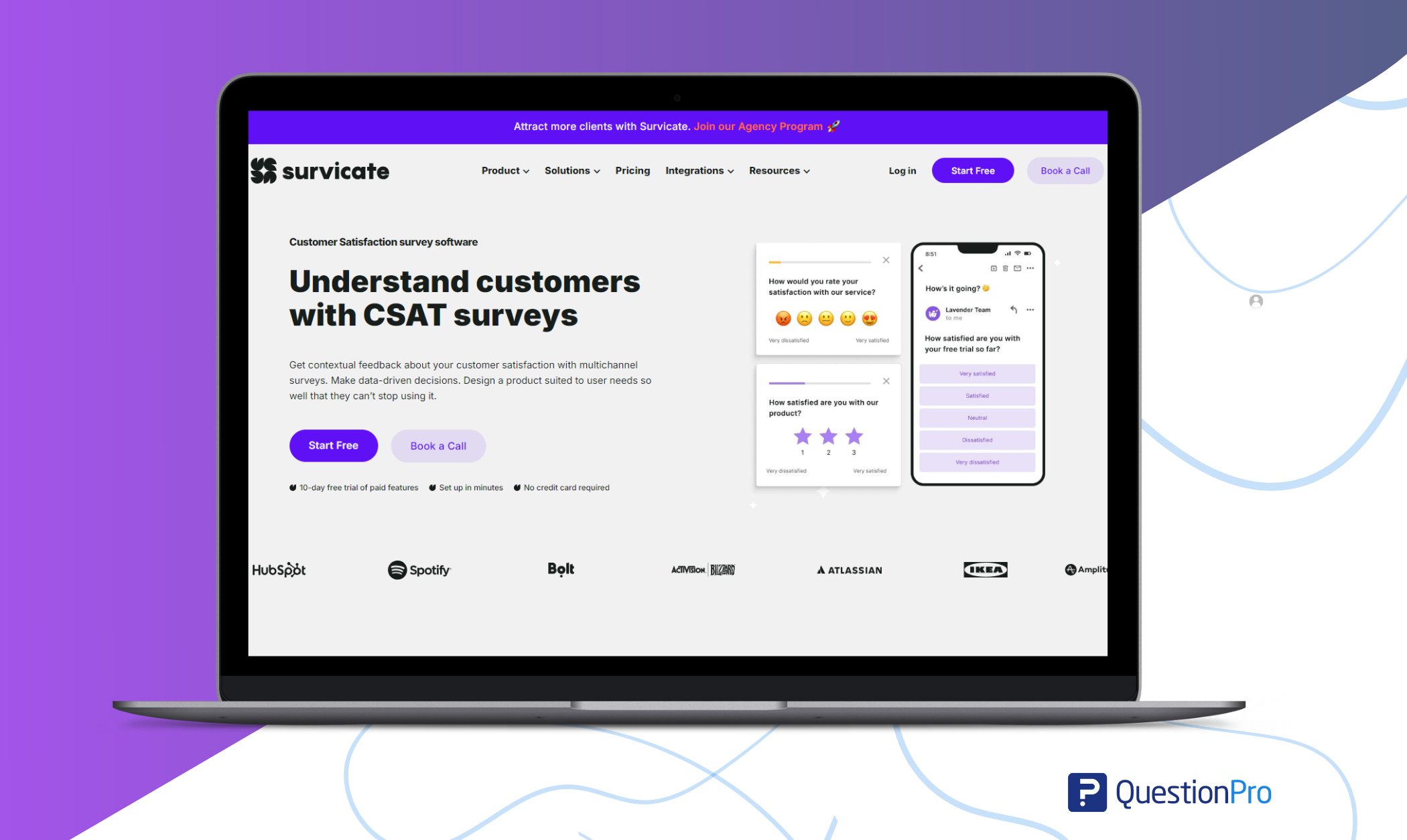
Best Features:
- Multi-channel feedback collection.
- Targeted website surveys.
- Integration with popular CRM and marketing tools.
Pros:
- Versatile feedback collection.
Cons:
- Some advanced features may require a learning curve.
17. ProProfs Survey Maker
ProProfs Survey Maker is a user-friendly tool that simplifies the survey creation process. It’s an ideal choice for businesses and educators alike, offering a range of survey types and customization options. With ProProfs, you can create surveys, quizzes, and polls effortlessly.
Best Features:
- Easy-to-use survey builder.
- Various question types, including quizzes and polls.
- Customizable survey themes.
Pros:
- Great for educational purposes.
Cons:
- Limited advanced features.
18. Podium
Podium is a customer interaction platform that includes a robust feedback component. It enables businesses to collect reviews, messages, and feedback from various channels. It provides a comprehensive view of customer sentiment. Podium is especially useful for businesses in the service industry.
Best Features:
- Multi-channel review collection.
- Review management.
- Integration with messaging platforms.
Pros:
- Holistic user interaction platform.
- Effective review management.
Cons:
- It may be more focused on specific industries.
19. Hotjar
Hotjar goes beyond traditional surveys and feedback forms by providing insights into user behavior through heatmaps and session recordings. This tool is perfect for businesses looking to understand how users interact with their websites or applications.
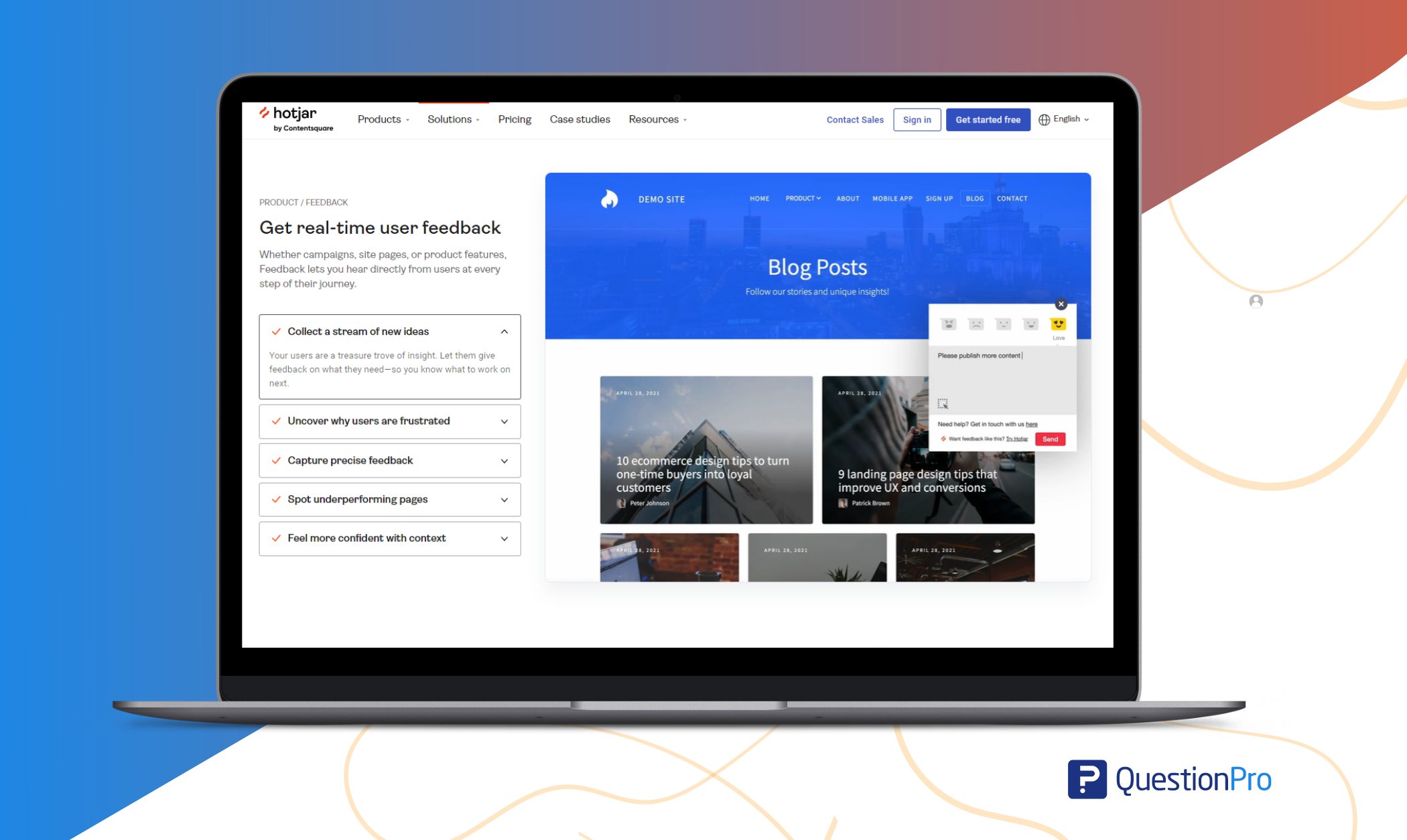
Best Features:
- Heatmaps and session recordings.
- Feedback polls and surveys.
- User behavior analytics.
Pros:
- Comprehensive website and app analytics.
- Visual representation of user interactions.
Cons:
- Limited to online platforms.
20. Feedbackify
Feedbackify is a powerful tool that empowers businesses to gather valuable insights and opinions from their customers. It offers a range of features to streamline the review collection process and transform insights into actionable strategies.
Best Features:
- Customizable feedback forms for diverse survey needs.
- Integration options with popular customer relationship management (CRM) systems.
- Real-time reporting and analytics.
Pros:
- Flexibility in designing surveys to match brand aesthetics.
- Comprehensive reporting tools for data-driven decision-making.
Cons:
- Limited free version.
Check out our new blog at QuestionPro for helpful insights on Customer Loyalty Software. It’s a quick read that could change how you think about loyalty!
Where to Use Customer Feedback Tools?
Customer feedback tools can be strategically used across various business areas to gather valuable insights and improve overall customer satisfaction. Here are some key areas where these tools can be effectively utilized:
1. Product Development and Improvement
- Idea Generation: Use feedback tools to gather customer suggestions for new product ideas or enhancements to existing products.
- Usability Testing: Collect feedback on product usability to identify areas for improvement.
- Beta Testing: Engage customers in beta testing and gather their insights before a full-scale launch.
2. Customer Support and Service
- Support Ticket Follow-Up: After resolving a customer support ticket, use feedback tools to gauge customer satisfaction with the resolution.
- Live Chat and Help Desk: Implement feedback surveys immediately after a live chat or help desk interaction to assess the quality of support provided.
- Customer Service Calls: Follow up on customer service calls with feedback surveys to measure the effectiveness of the interaction.
3. Sales and Marketing
- Post-Purchase Surveys: Send surveys after a purchase to understand customer satisfaction and gather insights on their buying experience.
- Website Experience: Collect feedback on the user experience of your website, including navigation, content, and ease of use.
- Campaign Effectiveness: Evaluate the effectiveness of marketing campaigns by gathering customer feedback on their impact and relevance.
4. Employee Performance and Training
- Employee Feedback: Collect customer feedback about employee interactions to assess performance and identify training needs.
- Mystery Shopping: Use feedback from mystery shoppers to evaluate employee adherence to service standards and overall customer experience.
5. User Experience (UX) and Design
- User Testing: Conduct user testing sessions and gather feedback on the design and functionality of digital products (e.g., websites, apps).
- A/B Testing: Use feedback tools to gather insights on different design versions during A/B testing to determine which performs better.
6. Compliance and Quality Assurance
- Regulatory Feedback: Collect feedback on compliance and regulatory issues to ensure your business meets industry standards.
- Quality Control: Gather customer feedback on product quality and service standards to maintain high levels of quality assurance.
Businesses can collect customer insights, enhance customer satisfaction, and drive continuous improvement by strategically using customer feedback tools in these areas.
How to Choose the Right Customer Feedback Tool?
Choosing the right customer feedback app requires careful consideration to ensure it aligns with your business needs and objectives. Here’s a summary of key factors to consider:
1. Ease of Use
Look for a tool that is user-friendly for both your team and customers. The easier it is to navigate and utilize, the more likely you’ll get valuable feedback. Quick installation and deployment should also be a priority.
2. Multi-channel Feedback
Consider a tool that supports collecting feedback across various channels (email, social media, phone, chat, etc.). This ensures you capture insights from different touchpoints, providing a holistic view of the customer experience.
3. Integrations
Choose a feedback tool that integrates with your existing applications. This customization and extensibility enhance your overall experience and streamline workflow. Compatibility with your current tech stack is essential for efficiency.
4. Pricing
Evaluate the pricing structure in relation to the features offered. Consider the value and return on investment (ROI) rather than just the upfront cost. Different plans, features, and support levels can impact the overall cost. So, choose a plan that aligns with your budget and requirements.
5. Customer Support
Responsive and helpful support is crucial to consider. It is important when you encounter issues or need assistance in maximizing the tool’s potential.
6. Trial Period
If possible, opt for a tool that offers a trial period. This allows you to test the features and functionality before committing fully. It’s an opportunity to ensure the tool aligns with your expectations and meets your business requirements.
By carefully considering these factors, you can select a customer feedback app that not only meets your immediate needs but also provides a foundation for ongoing improvement and customer satisfaction.
Curious about how to gain deeper insights into your customers? Explore QuestionPro’s recent blog on their Customer Insight Platform!
Why should you choose QuestionPro as your customer feedback tool?
Selecting QuestionPro as your customer feedback tool offers a range of compelling advantages that can significantly enhance your feedback-collecting and analysis process. Here’s why QuestionPro stands out:
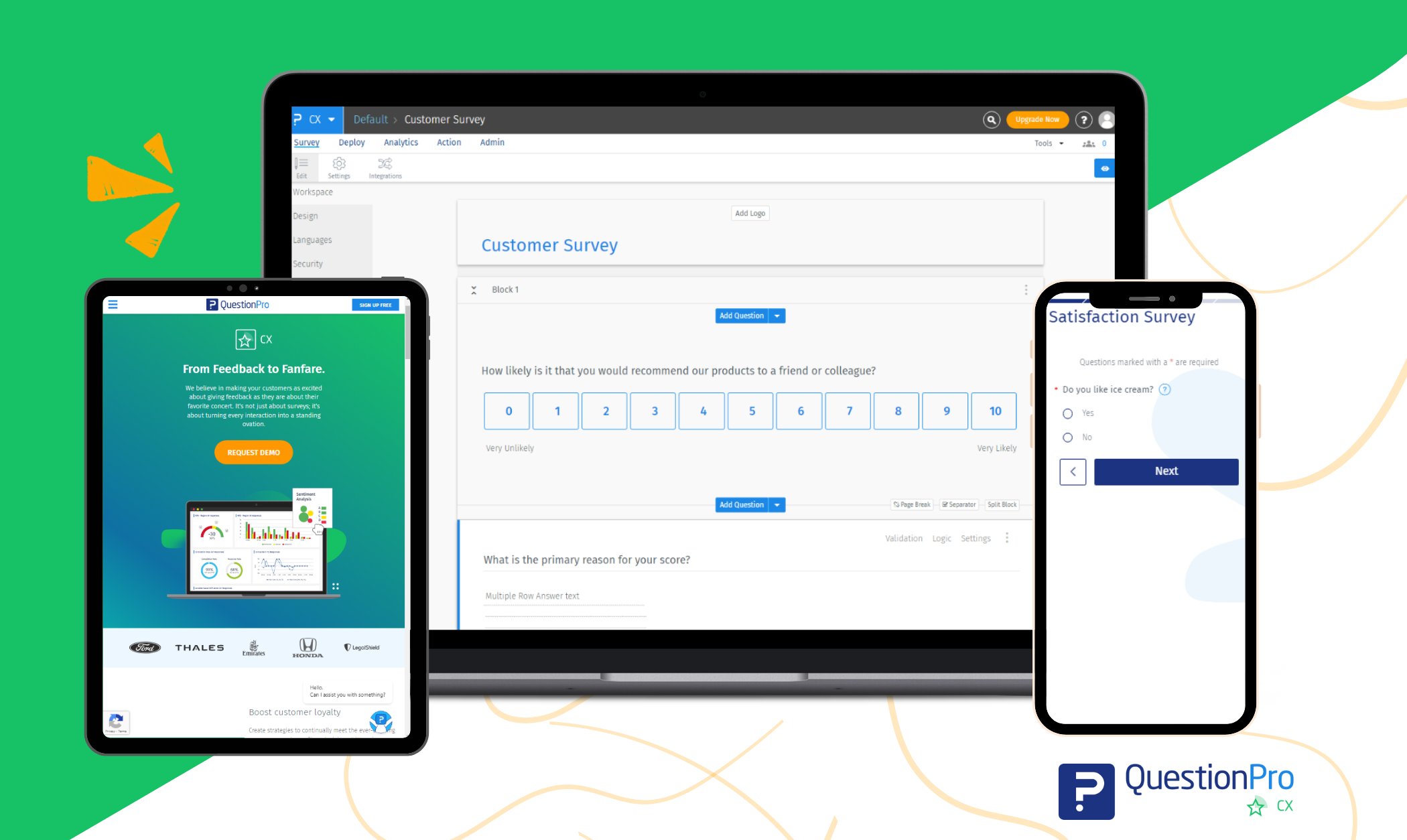
- Versatile Survey Capabilities: QuestionPro offers a versatile set of customer feedback tools to create surveys that range from quick pulse checks to improve customer satisfaction assessments.
- Real-Time Feedback Insights: QuestionPro delivers real-time feedback insights. It empowers you to respond promptly to customer concerns and stay updated with market conditions.
- Multi-channel Feedback Collection: QuestionPro supports multi-channel feedback collection. It allows you to engage with the audience through email, social media, or embedded customer surveys on websites. This platform ensures an excellent understanding of customer sentiment.
- Powerful Analytics and Reporting: You can extract meaningful insights effortlessly with QuestionPro’s robust analytics and reporting tools. You can visualize trends, identify areas for improvement, and make informed decisions using clear and concise reports.
- Customization Options: QuestionPro helps maintain brand consistency throughout the user feedback-collecting process. It allows you to customization, including logos and color schemes. QuestionPro ensures that surveys align seamlessly with your brand identity.
- Integration: QuestionPro integrates with other business tools, streamlining your workflow. It helps you to connect with CRM systems, export customer feedback data for further customer feedback analysis, and ensure a smooth and efficient integration process.
- Security and Compliance: Security is a top priority for QuestionPro. The platform complies with customer data protection regulations, ensuring the confidentiality and privacy of customer feedback.
- Transparent Pricing: QuestionPro offers transparent and flexible pricing plans. It allows businesses to choose a package that aligns with their budget and specific requirements. This transparency helps in planning and managing costs effectively.
- Responsive Customer Support: QuestionPro provides excellent customer support, ensuring that you have assistance whenever you need it. Whether through live chat, email, or phone, their support team is there to help address any queries or concerns.
Conclusion
This blog has taken you on a journey through the concept of customer feedback and the importance of customer feedback tools. We also discussed the top 20 advanced tools that can elevate your business game.
The top 20 customer feedback software explored in this blog offers a diverse range of features and capabilities. Whether you’re looking for real-time analytics or seamless integration, there’s a tool, QuestionPro, that aligns with your business needs.
QuestionPro offers you versatile customer survey capabilities, real-time insights, multi-channel engagement, and powerful analytics. It also provides survey customization options, seamless integration, security compliance, transparent pricing, and responsive customer support.
Choosing QuestionPro is not just selecting a tool; it’s partnering with a solution that elevates your understanding of customer experience to new heights. Contact QuestionPro for further information!
Frequently Asked Questions (FAQs)
A customer feedback software is tool that helps businesses collect, manage, and analyze the opinions and perceptions of anyone using your services or products.
These tools are designed to make it easier for companies to understand what their customers think about various aspects related to the customer journey and their overall experience.
Feedback tools are instruments, systems, or software applications designed to gather, analyze, and manage feedback from users, employees, customers, or other stakeholders.
Although these tools can vary widely in terms of functionality, they generally aim to improve processes, products, services, or overall performance by leveraging the insights gained from feedback.
Creating a customer feedback system involves:
1. Define Objectives: Clarify goals for feedback.
2. Choose Channels: Select feedback methods (surveys, social media).
3. Select Tools: Pick tools (QuestionPro, Zendesk).
4. Design Forms: Create precise surveys/forms.
5. Integrate Systems: Connect with CRM/support platforms.
6. Promote Feedback: Encourage customer participation.
7. Collect Feedback: Gather customer responses.
8. Analyze Data: Identify trends and issues.
9. Act on Insights: Implement changes.
10. Close the Loop: Inform customers of actions.
11. Monitor & Iterate: Continuously improve the system.







